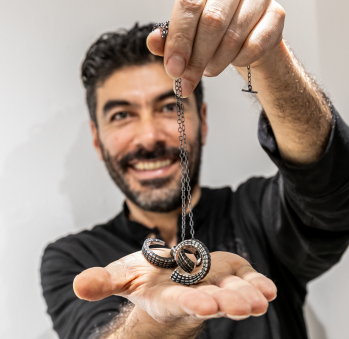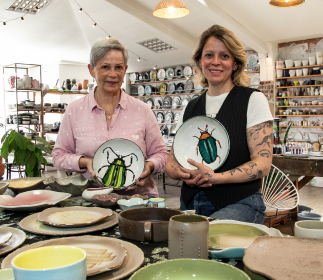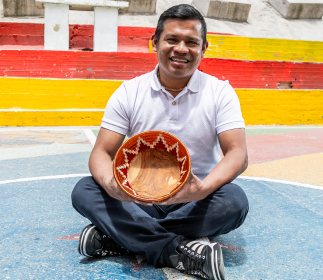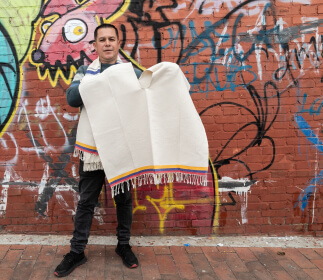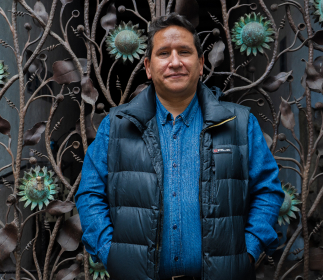Alexander Cortés
Workshop: Metalero
Craft: Jewelry/Fashion Jewelry
Trail: Bogotá Route
Location: Bogotá, Bogotá
SCHEDULE YOUR VISIT
calle 83 # 14A - 25 of 303, Bogotá
3142816596
alexxandercortes@gmail.com
@metalero.co
This is the story of a man who proudly identifies as a metalhead. He feels a strange symbiosis with minerals, recognizes them as part of his very essence, and knows they’ve become his language. “A person can speak French, another can speak English; I speak metal,” he declares with conviction. However, he only discovered this form of communication as an adult. Although he was born in Bogotá, he spent his childhood with his grandmother in the serene mountains between Gachancipá and Sesquilé until his mother brought him back to the capital. It was there that his father reappeared after a long absence, bringing with him what would define his destiny: a pawnshop in downtown Bogotá that had gained a reputation with the Cortés name. His father asked him to help out in the business, along with his uncle. Accepting, he was introduced to the unique world of those men who trade on foot along the Jiménez Avenue and La Candelaria neighborhood—an enigmatic and mysterious landscape for outsiders, where they are seen touching stones, feeling them, examining them closely, and negotiating their values.
Alexander had no idea about the trade of precious stones or the buying and selling of gold and silver. It was a whole new world to him, but one he quickly embraced. His interest in metalworking had already begun when a friend sent him a newspaper clipping about a jewelry program at Sena. With this new path opening up before him, he discovered that he enjoyed working with these materials, so he started learning everything on the fly. On one side, there was the craft; on the other, metal as a currency. He admits he paid his dues, getting robbed many times—what in the trade is called “paying for the course.” But he took advantage of these experiences, understanding that the essence of the trade is not just business but the relationship with others, and that everything related to metals revolves around words (and silence) and looks. Through this journey, he learned some of the most important lessons of his life, including how to lose—since there’s a lot of losing, but also a lot of gaining. It’s a matter of not clinging to anything and learning to trust. He learned about humanity.
Although he became quite skilled and had a diverse clientele—including jewelers needing liquidity who pawned their creations for a few days and very local ladies who brought him silver trays and tea sets from their ancestors for him to melt down—he was captivated by the work of great goldsmiths, both past and present. This fascination led him to create his visual archive and commit to the craft as his life’s work. The Gold Museum also became his guide.
He stepped away from his father’s business and dedicated himself entirely to silversmithing. While this transformation was taking place in his mind and hands, he studied jewelry techniques at Sena and deepened his knowledge at the Santo Domingo School of Arts and Crafts. He discovered he loved working with silver in its purest form, i.e., in Law 999 or even 1000, meaning without any alloy. As his career solidified, his son Jacobo grew up and introduced him to a new area of exploration: traditional mythology of our territory. Alexander began to imagine compact pieces that could be turned into sculptures. He created mohanes, caiman men, fireballs, and patasolas, which eventually were exhibited at international auction houses. In fact, almost as if it were an omen, it was Beatriz Santo Domingo who bought his magnificent Mohán during his first participation in Expoartesanías.
And as a metalhead always searching for meaning, he has devoted himself to developing the technique of beating, honoring the pre-Hispanic traditions that used it long ago. This involves endlessly hammering the metal until it is laminated. For him, these are hours and days where the sound of the hammer becomes his form of meditation, his mantra. One that signals, without formulas, that the metal is ready to be worked, and similarly, announces that it is prepared. Perhaps this is why the necklaces he makes look so powerful—they carry the aura of time. As Alex puts it, “This is in my blood, this metal.”
Craft


















Artisans along the way
Artisans along the way
No puede copiar contenido de esta página








































